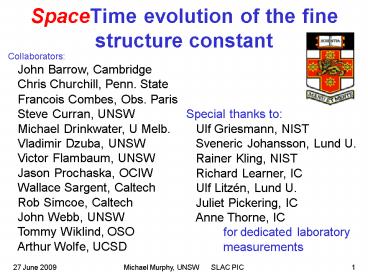SpaceTime evolution of the fine structure constant - PowerPoint PPT Presentation
1 / 20
Title:
SpaceTime evolution of the fine structure constant
Description:
Michael Murphy, UNSW SLAC PIC. 1. SpaceTime evolution of the fine structure constant ... Michael Murphy, UNSW SLAC PIC. 11. The alkali doublet (AD) method: The ... – PowerPoint PPT presentation
Number of Views:114
Avg rating:3.0/5.0
Title: SpaceTime evolution of the fine structure constant
1
SpaceTime evolution of the fine structure constant
Collaborators John Barrow, Cambridge Chris
Churchill, Penn. State Francois Combes, Obs.
Paris Steve Curran, UNSW Michael
Drinkwater, U Melb. Vladimir Dzuba, UNSW
Victor Flambaum, UNSW Jason Prochaska, OCIW
Wallace Sargent, Caltech Rob Simcoe, Caltech
John Webb, UNSW Tommy Wiklind, OSO Arthur
Wolfe, UCSD
Special thanks to Ulf Griesmann, NIST
Sveneric Johansson, Lund U. Rainer Kling,
NIST Richard Learner, IC Ulf Litzén, Lund
U. Juliet Pickering, IC Anne Thorne,
IC for dedicated laboratory measurements
2
Outline
- Motivations for a varying ae2/hc
- Limits on Da/a
- Laboratory
- Oklo fission reactor
- QSO absorption systems
- The old alkali doublet (AD) method
- The new many-multiplet (MM) method
- Our recent results A non-zero Da/a?
3
Motivations for varying constants
- Modern unified theories (e.g. String/M-theory)
invoke extra spatial dimensions. - Our (31)-dimensional constants related to scale
sizes of extra dimensions. - M-theory gravity acts in all 11 dimensions but
other forces (EM, strong, weak) act only in
4-dimensions. - Expect variations in G on small (0.1mm) scales.
4
Motivations for varying constants
- Varying c theories can solve cosmological
problems (e.g. horizon problem ? smaller ae2/hc
in the past). - Bekensteins (1982) varying-e theory spacetime
variations of a scalar field drive variations in
e. - Sandvik, Barrow Magueijo (2001) Bekensteins
theory cosmology ? predictions of cosmological
variations in a.
5
Limits on Da/a laboratory
- Atomic clocks relativistic corrections are of
order (Za)2. - Prestage et al. (1995) compared Hydrogen maser
and Mercury clocks Da/a ? 1.410-14 over 140
days (assumes gp/gHg constant). - Sortais et al. (2001) compared Rubidium and
Cesium clocks Da/a (0.8 1.4)10-14 over 2
years (assumes gRb/gCe constant). - Clocks with similar Z can constrain varying
g-factors (e.g. Godone et al. 1993). Stability
advantage.
6
Limits on Da/a Oklo
http//www.curtin.edu.au/curtin/centre/waisrc/OKLO
7
Limits on Da/a Oklo
- Heavy nuclei (e.g. Sm) have sharp resonances in
their neutron absorption cross-section ? - Sm isotopic abundances ? 149Sm neutron absorption
cross section ? neutron capture resonance energy
? Da/a. - 1976 Shlyakhter first analyzed Sm abundances
from Oklo to constrain Da/a. - 1996 Damour Dyson re-analyzed the same data to
obtain a stronger constraint Da/a - 2000 Fujii et al. find Da/a(-0.040.15)10-7
from new data.
8
QSO absorption lines
Quasar
To Earth
Lyaem
CIV
SiII
SiIV
CII
SiII
Lyman limit
Lya
Lyb
Lybem
NVem
Lya forest
CIVem
SiIVem
9
QSO absorption lines
- A Keck/HIRES doublet
Quasar Q175975
H emission
Over 60 000 data points!
Separation ? a2
H absorption
C IV doublet
Metal absorption
C IV 1550Å
C IV 1548Å
10
The alkali doublet (AD) method
- 1976 Wolfe, Brown Roberts first applied the AD
method to intervening Mg II absorption lines. - 2000 Varshalovich et al. recently obtained
Da/a(-4.6 4.3 1.4)10-5 using the AD method
with 16 Si IV absorption systems (zavg2.6). - 2001 We have used improved lab wavelengths and
new data from Keck to findDa/a(-0.5 1.3)10-5
(zavg2.8).
11
The alkali doublet (AD) method
- The AD method is simple but inefficient.
- The common S ground state in ADs has maximal
relativistic corrections!
12
The many-multiplet (MM) method
- Relativistic corrections for many-electron atoms
- Compare light (Z10) and heavy (Z30) ions OR
- S ? P and D ? P transitions in heavy ions.
- More formally, we write the transition frequency
as wzw0qx for x(az/a0)2 1. - We must calculate q and measure w0.
13
Low-z vs. High-z constraints
Low-z (0.5 1.8)
High-z (1.8 3.5)
14
Low-z vs. High-z constraints
High-z
Low-z
15
Current results
16
Potential systematic effects
- Laboratory wavelength errors
- Heliocentric velocity variation
- Temperature changes during observations
- Line blending
- Differential isotopic saturation
- Hyperfine structure effects
- Instrumental profile variations
- and of course, Magnetic fields
- Wavelength calibration errors
- Atmospheric refraction effects
- Isotopic ratio evolution
17
Radio constraints H I 21-cm vs. mm
- Hydrogen hyperfine transition at lH 21cm.
- Molecular rotational transitions CO, HCO, HCN,
HNC, CN, CS etc. in the mm-band. - wH/wM ? a2gP where gP is the proton magnetic
g-factor.
18
(No Transcript)
19
All current constraints
20
Conclusions
- 3 independent optical samples now agree!
- There IS an effect in the data but is it a
varying a or just undiscovered systematic
effects? - Must get spectra from different telescope ? UVES!
- Must also find more H I 21cm/mm absorbers.
- Potential constraints from combining optical
spectra and H I 21cm spectra ( 5 good
candidates). - Higher-z tests CMB and BBN constraints (1
precision).































